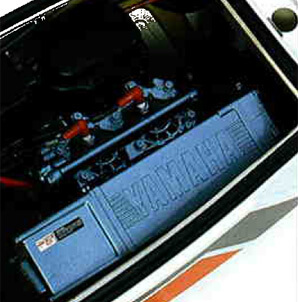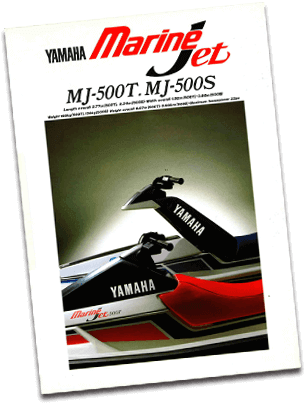Story
Production of the first marine jet - the WaveRunner 500 (Marine Jet 500T) - began in 1986, generating a huge reaction among marine fans across the globe. 30 years have passed since that time. We talked with the man known as "WaveRunner Papa", the development manager at that time, Neil Kobayashi.
It all Began in the Early 1970's in Shonan
I was stationed in Shonan, the center of Japan's marine leisure in the 1970's. At this time, as there was no need for licenses or certification on small watercraft, people were free to use the water areas how they felt taking responsibility for themselves. Shonan, being close to Yokohama and Yokosuka, made it easy to launch boats and other W/V type craft off into the ocean very freely. There were many different types of craft available such as scaled-down versions of small boats, surfboards fitted with propelling devices and underwater wings etc.
At the time, marine leisure was thought of not being available for everyone and really only the elite - I remember thinking about possibilities to provide this type of enjoyment in easier ways for the more average person. However, as I had only just joined the company, on a technical level, I was not in a position at which I could exercise any authority. Even so, I felt that I would one day like to make a craft of this type. This was the opportunity to create the WaveRunner.
Development in Tough Times and Failure in America
After this, development of small watercraft was very popular overseas, with only a small number of companies producing W/V type craft at a manufacturing level - and then in 1979, a limited number were brought into Japan. At this time in Japan, there was now an obligation for even small watercraft to be licensed and certified, and as legal technical standards had to be set, the Ministry of Transport (Now: Ministry of Land, Infrastructure, Transport and Tourism) requested cooperation from the Japan Marine Industry Association. At this time, as I was on the technical committee of the Japan Marine Industry Association, and that I had some knowledge and experience, I was asked to do some research into the company's marina and carry out repeated performance confirmation tests into the level of safety at Shonan. As a result, the next year in 1980, we issued "water-bike special standards" to create the legal framework required for people to enjoy marine leisure safely.
However, when it came to the company's development of personal watercraft, there was a mindset at the time that "Yamaha makes motorboats", and so while I was able to assist in drawing up plans for the legal side, I did not receive any permission in regard to their deployment.
Then in around 1983, as the company entered a managerial crisis and became unable to manage the business focusing solely on its key products, an opportunity emerged within the company to create new products with a more competitive edge. During this period, as I was responsible for experimentation, and by managing to complete current work at 80%, I was able to free up 20% capacity, which I shifted to carrying out development of the personal watercraft as a new product.
Through repeated trial and error, we completed our prototype of the "Power-Ski." It was in this time that we received a request from YMUS (YAMAHA MOTOR CORPORATION, U.S.A.), one of Yamaha Motor's overseas group companies, that they would like to see a presentation. That request came from a friend and superior that I used to work with in my Shonan days, which was now stationed in the YMUS.
In September of 1984, with models from other companies using 15 horsepower pumps placed directly onto board models, Yamaha Motor revised the boat for the American market changing out the engine for a 25 horsepower option. However the results were varied and far less than expected. The power-ski with its small engine and the aim of being a small and lightweight model, just didn't suit the American driver that exceeded 100kg. The 25 horsepower pump simply did not have enough power, causing most 'would-be' operators to give up while trying just to get on the craft, let alone use it.
At the post test meetings we had a really difficult time keeping up good relations in looking for good points to talk about.
The weight of our power-ski was a lightweight 65kg. On talking with the locals, the general feeling was that the weight should not be able to be lifted up by hand, should be towed around on a trailer, and would be no problem if it was around the 130kg mark. Furthermore, in YMUS, on hearing the investigation report for placing the power-ski into the small boat category from the W/V, I remembered my time at Shonan and felt confident that I could handle the request from the Americans "with fun riding at one-up types as well as tandem types".
In February 1985, and with the backing of YMUS, the in-house MMV (Mini Marine Vehicle) project formally began. Development began on the single and tandem models in accordance with YMUS requests.
Jet Engine Creation and Innovative Plans Toward Success

It was a case of having to work in these areas with development focused towards production of engine and jet propulsion devices on mass. We held talks with Sanshin Industries who (at the time) were carrying out engine development for outboard motors with the hope of looking at engine development and jet propulsion devices.
We thought that if we could get 50 horsepower, we could create a very enjoyable watercraft, however out of all the outboard motors that could function as the base engine, the upper limit was only 30 horsepower, so we started engine development under the framework of "We will have to make do with 30 horsepower".
Within the realm of only being able to offer power up to 30 horsepower, one option that came to mind was the combination of double chines incorporated into the Shallow V model. To increase speed with less horsepower, we used a double chines at the optimum width on the inner side in order to cut through the water. Then, a hull was created that would simultaneously bring static stability to the hull through the fitting of outer side chines, would allow the thrill of controllable fast speed turns when the center of gravity moves forward, and also provide sharp edge turning when the hull was tipped to one side.
After this phase, came a series of repeated cruising adjustments - almost on a daily basis - which finally resulted in a new type of mobility that captivated people the world over.
In July 1985, we came to a presentation to YMUS that we knew could not fail. The test riders were motorcycle and snow-mobile riders that had also attended the first test rides. This time, the test riders that tried out the tandem models just wouldn't get off. When they finally did actually get off, they all just raised their thumbs and said "Excellent!" Everyone was really excited, and lining up to test ride the different products. There was almost no time to get any other type of feedback.
It was just that greater response. But the thing that sticks in my mind most clearly was when one motorcycle rider who had, on top of giving us a scathing review at our first test at YMUS, had said that what we wanted to produce was impossible with our company's technology, this time, he gave us the highest praise "This is what I've always wanted. It's ideal."

With that, the tandem model became a tentative production project, and "Wave Runner" was chosen as the model name.
However, due to the complexity of the single model's wings, improvement became necessary afterwards, and at the same time we were making presentations to YMUS of the prototype watercraft "WaveJammer", with the same boat-shaped construction as the tandem model, and the fixed steering specialized for one extra rider, these improvements were also set as tentative production projects.
From this point onwards, with the need to improve marketability and reliability, we coordinated with the departments in charge of design, testing, quality assurance, service and creating manuals, and almost every day was a cycle of test rides and inspections.
After much accumulated effort across the company as a whole, production began on the tandem model, "WaveRunner 500 (Marine Jet 500T) in October 1986, and on the "WaveJammer 500 (Marine Jet 500S)" in February 1987. Following this, there was strong inquiry from many different countries, and all of a sudden, it was a popular addition to beaches everywhere.
What is Hoped for From the Next Generation's Engineers
30 years have flown by since I started in development.
The thing I consider most unfortunate is that the fundamental concept of the personal water craft has not changed from what it was when I was involved. It is my wish that Yamaha has and keep its traditional attitude ,"Spirit of Challenge", and overhauls the concept that has been used until now and creates something new and enjoyable that excites people. I have high hopes of this happening.

